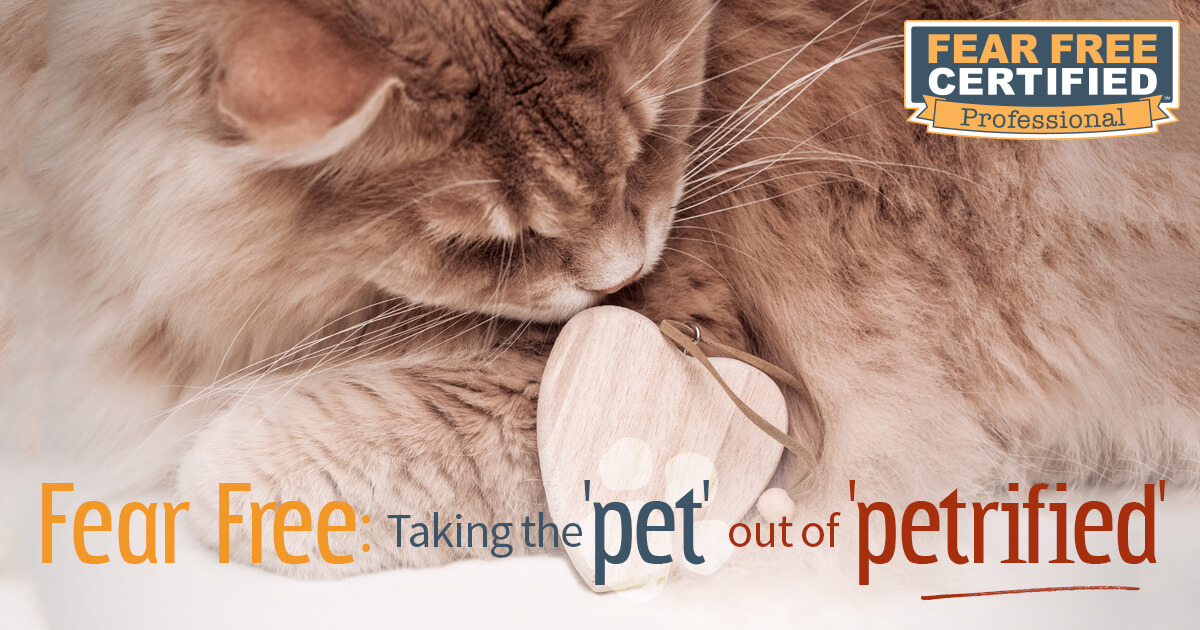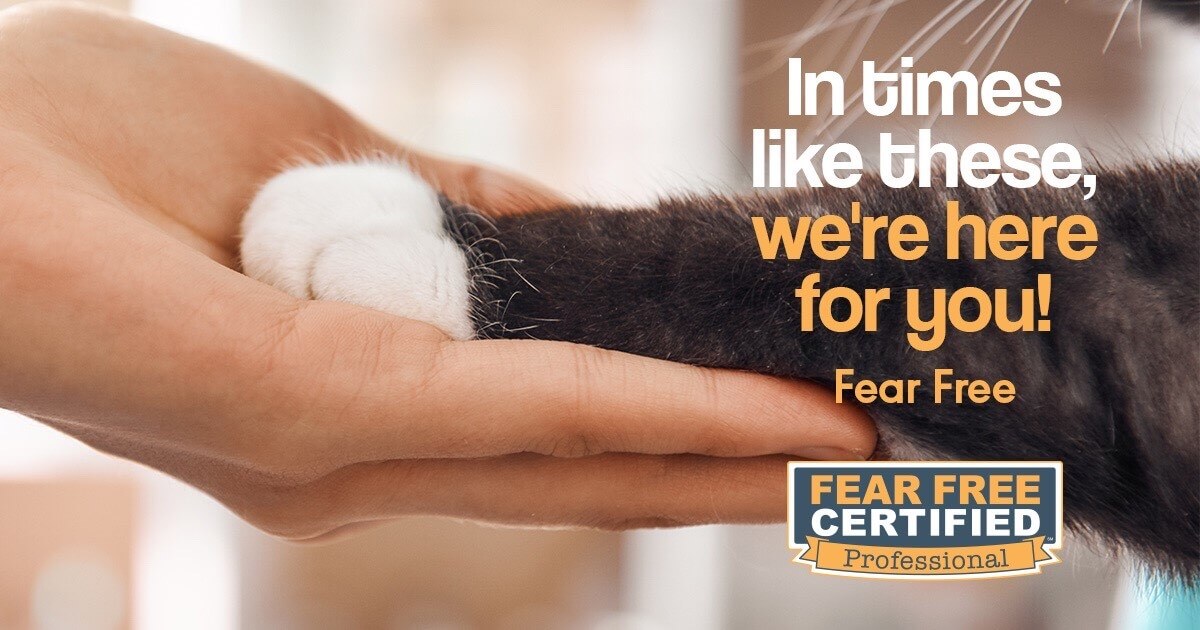FEAR FREE VETERINARY VISIT
Better for your pet, better for you: How Fear Free is Changing Veterinary Visits
For many pets and their owners, going to the veterinarian can cause feelings of fear, anxiety, and stress. Stressful veterinary visits are problematic for pets, pet owners, and veterinary healthcare team members. That’s why Dr. Marty Becker, “America’s Veterinarian,” founded a certification program—called Fear Free —that helps veterinary healthcare professionals learn how to make visits to the vet something pets and their owners can both look forward to.

We are proud to have Fear Free Certified® Professionals on our team
We’ve always worked hard to provide the best care for your pets. Now, we know that there are ways to make your pet’s healthcare even better. We’re proud that our team members are evolving with veterinary medicine and are committed to looking after both your pet’s physical and emotional well being.
The Fear Free mission is to prevent and alleviate fear, anxiety, and stress in pets by inspiring and educating the people who care for them. Click here to go to the Fear Free Pets Website.
Fear Free Happy Homes
Become a member of Fear Free Happy Homes and get access to the most cutting-edge content and education to help brighten and enrich your pet’s life to the fullest.
Our contributors are recognized as the leading experts in their fields of veterinary medicine, animal handling, training, and research, and we take pride that 100 percent of our content is reviewed by boarded veterinary behaviorists.
As part of the complimentary membership, get access to:
- A growing library of articles, tips, tricks & other resources to enhance your pet’s emotional wellbeing and provide them with the best enrichment
- Veterinary visit handouts to make your next visit Fear Free
- Monthly Fear Free Friday deals on hand-picked pet products & services
- The Fear Free online directory to locate Fear Free veterinary and pet professionals near you
- One-of-a-kind educational videos
- An interactive community
- Exclusive, ongoing discounts on products
The Signs of Stress
Your pet is hiding. They’re not napping; they’re scared! Many signs of fear, anxiety, and stress in pets are difficult to detect. Here are some of the most common signs that your pet might be feeling less than calm and content:
- Tail down, tucked, or high over the back
- Closeness to you or climbing up on you
- Panting
- Fidgeting (circling, barking, not able to sit still)
- Trembling
- Yawning
- Pacing
- Whining, growling, snarling, or biting
- Piloerection (hair up)
- Hypervigilance (looking around everywhere, seemingly paranoid)
- Lunging
- Dilated pupils
- Licking lips, or lips drawn back
- Hiding
- Turning away when you look at them, or turning their back to stimuli
- Avoiding veterinary team members

The Fear Free Veterinary Visit
During a typical Fear Free veterinary visit, the practice team members might use the following strategies:
- Initially avoid eye contact with your pet and focus on you instead
- Provide non-slip surfaces for your pet to stand or rest on to improve balance and enhance stability
- Use gentle pressure to soothe the pet using a towel or compression garment
- Create a calming environment with pheromone diffusers and aromatherapy
- Play calming music to ease tension and promote relaxation
- Actively work to reduce stressful noises
- Create a relaxing environment through calming hospital colors and gentle lighting
- Prescribe anti-anxiety or other calming medications & supplements
- If your pet is showing excessive signs of fear, anxiety, or stress, the team may delay or postpone the exam or other procedures until a time when the pet is calmer and more relaxed
Five Ways You Can Help Make the Veterinary Visit Fear Free for Your Pet
Prep your pet – Positively accustom the pet to her carrier or restraint device and condition happy experiences in the vehicle.
Limit food before the appointment unless medically contraindicated – Bringing pets in hungry increases the reward value of food during the visit to better condition the pet to the positives of care.
Explore waiting room alternatives – Work with the receptionist or other team members to determine the optimal location to wait with your pet prior to care.
Be open to non-traditional techniques – This can include not taking the pet’s temperature, examining the pet in your lap or on the floor, and using treat and toy coaxers to move animals willingly onto the scale, into the exam room, and onto the table.
Consider proven, new strategies to reduce fear, anxiety, and stress in your pet – In many cases, pets will benefit tremendously from pre-visit medications, supplements, or sedatives, as well as conditioning the pet to aspects of vet care prior to the next visit.
Click the below link to learn more!
https://www.fearfreehappyhomes.com/
Fear Free Pre-visit Questionnaire
Please fill out the following form before your patient’s next visit so that we can give your pet the best Fear Free experience possible.

